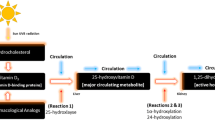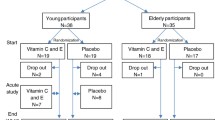Abstract
Master athletes are more than 35 years of age and continue to train as hard as their young counterparts despite the aging process. All life long, they are capable of accomplishing exceptional sporting performances. For these participants in endurance events, matching energy intake and expenditure is critical to maintain health and performance. The proportions of carbohydrate, fat, and protein must be optimized to provide enough calories to sustain the energy requirements of competition or training, and for recovery. In addition, endurance athletes must include adequate vitamins and minerals in their diets to maintain healthy immune function. Vitamins and minerals may be sufficient in the diets of endurance athletes, who have a high energy intake. This would make it unnecessary to use vitamin and mineral supplements. Furthermore, one major limitation for these athletes is the management of oxidative stress, which, when in excess, can be deleterious for the organism. For individuals exposed to oxidative stress, micronutritional supplementations rich in vitamins and minerals can be also an alternative strategy. Although these supplementations are increasingly used by master athletes, very few data are available on their effects on oxidative stress, muscle recovery, and physical performance. The potential benefits of supplement use in athletes are thus questionable. Some studies indicate no benefits, while others highlight potential negative side effects of vitamin supplementation. Additional studies are warranted in order to design adapted prescriptions in antioxidant vitamins and minerals.
Similar content being viewed by others
References
Trappe S. Marathon runners: how do they age? Sports Med. 2007;37(4–5):302–5.
Bernard T, Sultana F, Lepers R, Hausswirth C, Brisswalter J. Age-related decline in Olympic triathlon performance: effect of locomotion mode. Exp Aging Res. 2010;36(1):64–78.
Lepers R, Maffiuletti N. Age and gender interactions in ultra-endurance performance: insight from triathlon. Med Sci Sports Exerc. 2011;43:134–9.
Reaburn P, Dascombe B. Endurance performance in masters athletes. Eur Rev Aging Phys Act. 2008;5(1):31–42.
Tanaka H, Seals DR. Endurance exercise performance in masters athletes: age-associated changes and underlying physiological mechanisms. J Physiol. 2008;586(1):55–63.
Calder PC, Kew S. The immune system: a target for functional foods? Br J Nutr. 2002;88(Suppl 2):S165–77.
Burke LM, Read RS. Diet patterns of elite Australian male triathletes. Phys Sportsmed. 1987;5:140–55.
Mastaloudis A, Traber MG, Carstensen K, Widrick JJ. Antioxidants did not prevent muscle damage in response to an ultramarathon run. Med Sci Sports Exerc. 2006;38(1):72–80.
McGinley C, Shafat A, Donnelly AE. Does antioxidant vitamin supplementation protect against muscle damage? Sports Med. 2009;39(12):1011–32.
Peternelj TT, Coombes JS. Antioxidant supplementation during exercise training: beneficial or detrimental? Sports Med. 2011;41(12):1043–69.
Nieman DC, Henson DA, McAnulty SR, McAnulty LS, Morrow JD, Ahmed A, et al. Vitamin E and immunity after the Kona Triathlon World Championship. Med Sci Sports Exerc. 2004;36(8):1328–35.
Striegel H, Simon P, Wurster C, Niess AM, Ulrich R. The use of nutritional supplements among master athletes. Int J Sports Med. 2006;27(3):236–41.
Knez WL, Peake JM. The prevalence of vitamin supplementation in ultraendurance triathletes. Int J Sport Nutr Exerc Metab. 2010;20(6):507–14.
Ji LL, Dillon D, Wu E. Alteration of antioxidant enzymes with aging in rat skeletal muscle and liver. Am J Physiol. 1990;258(4 Pt 2):R918–23.
Wei YH, Lu CY, Wei CY, Ma YS, Lee HC. Oxidative stress in human aging and mitochondrial disease—consequences of defective mitochondrial respiration and impaired antioxidant enzyme system. Chin J Physiol. 2001;44(1):1–11.
Pinzani P, Petruzzi E, Orlando C, Stefanescu A, Antonini MF, Serio M, et al. Reduced serum antioxidant capacity in healthy centenarians. Clin Chem. 1997;43(5):855–6.
Squier TC. Oxidative stress and protein aggregation during biological aging. Exp Gerontol. 2001;36(9):1539–50.
Packer L. Highlight: oxidative stress. Biol Chem. 2002;383(3–4):345.
Stadtman ER. Protein oxidation and aging. Science. 1992;257(5074):1220–4.
Balaban RS, Nemoto S, Finkel T. Mitochondria, oxidants, and aging. Cell. 2005;120(4):483–95.
Sohal RS, Mockett RJ, Orr WC. Mechanisms of aging: an appraisal of the oxidative stress hypothesis. Free Radic Biol Med. 2002;33(5):575–86.
Kirkwood TB, Shanley DP. Food restriction, evolution and ageing. Mech Ageing Dev. 2005;126(9):1011–6.
Brooks SV, Faulkner JA. Skeletal muscle weakness in old age: underlying mechanisms. Med Sci Sports Exerc. 1994;26(4):432–9.
Faulkner JA, Brooks SV. Muscle fatigue in old animals. Unique aspects of fatigue in elderly humans. Adv Exp Med Biol. 1995;384:471–80.
Krotkiewski M, Brzezinska Z. Lipid peroxides production after strenuous exercise and in relation to muscle morphology and capillarization. Muscle Nerve. 1996;19(12):1530–7.
Mastaloudis A, Morrow JD, Hopkins DW, Devaraj S, Traber MG. Antioxidant supplementation prevents exercise-induced lipid peroxidation, but not inflammation, in ultramarathon runners. Free Radic Biol Med. 2004;36(10):1329–41.
Ji LL. Exercise at old age: does it increase or alleviate oxidative stress? Ann N Y Acad Sci. 2001;928:236–47.
Ji LL. Antioxidant signaling in skeletal muscle: a brief review. Exp Gerontol. 2007;42(7):582–93.
Harman D. Role of anti-oxidant nutrient in aging. Age. 1995;18:51–62.
Cruz JA, Moreiras-Varela O, van Staveren WA, Trichopoulou A, Roszkowski W. Intake of vitamins and minerals. Euronut SENECA investigators. Eur J Clin Nutr. 1991;45(Suppl 3):121–38.
Riboli E, Norat T. Epidemiologic evidence of the protective effect of fruit and vegetables on cancer risk. Am J Clin Nutr. 2003;78(3 Suppl):559S–69S.
Hu P. Plant-based food and prevention of cardiovascular diseases. Am J Cln Nutr. 2003;78:544–52.
Pavia M, Pileggi C, Nobile CG, Angelillo IF. Association between fruit and vegetable consumption and oral cancer: a meta-analysis of observational studies. Am J Clin Nutr. 2006;83(5):1126–34.
Lunet N, Lacerda-Vieira A, Barros H. Fruit and vegetables consumption and gastric cancer: a systematic review and meta-analysis of cohort studies. Nutr Cancer. 2005;53(1):1–10.
Gandini S, Merzenich H, Robertson C, Boyle P. Meta-analysis of studies on breast cancer risk and diet: the role of fruit and vegetable consumption and the intake of associated micronutrients. Eur J Cancer. 2000;36(5):636–46.
Vincent-Baudry S, Defoort C, Gerber M, Bernard MC, Verger P, Helal O, et al. The Medi-RIVAGE study: reduction of cardiovascular disease risk factors after a 3-mo intervention with a Mediterranean-type diet or a low-fat diet. Am J Clin Nutr. 2005;82(5):964–71.
Rissanen TH, Voutilainen S, Virtanen JK, Venho B, Vanharanta M, Mursu J, et al. Low intake of fruits, berries and vegetables is associated with excess mortality in men: the Kuopio Ischaemic Heart Disease Risk Factor (KIHD) Study. J Nutr. 2003;133(1):199–204.
Beck MA. Selenium and host defence towards viruses. Proc Nutr Soc. 1999;58(3):707–11.
James JS. Selenium: important new review of health findings. AIDS Treat News. 2000;347:3–4.
McBride JM, Kraemer WJ, Triplett-McBride T, Sebastianelli W. Effect of resistance exercise on free radical production. Med Sci Sports Exerc. 1998;30(1):67–72.
Barnett A. Using recovery modalities between training sessions in elite athletes: does it help? Sports Med. 2006;36(9):781–96.
Nieman DC, Henson DA, Smith LL, Utter AC, Vinci DM, Davis JM, et al. Cytokine changes after a marathon race. J Appl Physiol. 2001;91(1):109–14.
Lepers R, Hausswirth C, Maffiuletti N, Brisswalter J, van Hoecke J. Evidence of neuromuscular fatigue after prolonged cycling exercise. Med Sci Sports Exerc. 2000;32(11):1880–6.
Schaal K, Le Meur Y, Bieuzen F, Petit O, Hellard P, Toussaint JF, et al. Effect of recovery mode on postexercise vagal reactivation in elite synchronized swimmers. Appl Physiol Nutr Metab. 2013;38(2):126–33.
Hausswirth C, Louis J, Bieuzen F, Pournot H, Fournier J, Filliard JR, et al. Effects of whole-body cryotherapy vs. far-infrared vs. passive modalities on recovery from exercise-induced muscle damage in highly-trained runners. PLoS One. 2011;6(12):e27749.
Vollaard NB, Shearman JP, Cooper CE. Exercise-induced oxidative stress: myths, realities and physiological relevance. Sports Med. 2005;35(12):1045–62.
Close GL, Ashton T, McArdle A, Maclaren DP. The emerging role of free radicals in delayed onset muscle soreness and contraction-induced muscle injury. Comp Biochem Physiol A Mol Integr Physiol. 2005;142(3):257–66.
Jackson MJ. Free radicals generated by contracting muscle: by-products of metabolism or key regulators of muscle function? Free Radic Biol Med. 2008;44(2):132–41.
Urso ML, Clarkson PM. Oxidative stress, exercise, and antioxidant supplementation. Toxicology. 2003;189(1–2):41–54.
Lee J, Goldfarb AH, Rescino MH, Hegde S, Patrick S, Apperson K. Eccentric exercise effect on blood oxidative-stress markers and delayed onset of muscle soreness. Med Sci Sports Exerc. 2002;34(3):443–8.
Sen CK. Oxidants and antioxidants in exercise. J Appl Physiol. 1995;79(3):675–86.
Davies KJ, Quintanilha AT, Brooks GA, Packer L. Free radicals and tissue damage produced by exercise. Biochem Biophys Res Commun. 1982;107(4):1198–205.
Davis JM, Alderson NL, Welsh RS. Serotonin and central nervous system fatigue: nutritional considerations. Am J Clin Nutr. 2000;72(2 Suppl):573S–8S.
Nielsen P, Nachtigall D. Iron supplementation in athletes. Current recommendations. Sports Med. 1998;26(4):207–16.
Hausswirth C, Caillaud C, Lepers R, Brisswalter J. Influence of a vitamin supplementation of locomotion gross efficiency after an ultra-trail running race. Sci Sports. 2006;21(1):8–12.
Gauche E, Hausswirth C, Bieuzen F, Lepers R, Rabita G, Brisswalter J. Vitamin and mineral complex supplementation on maximal voluntary contraction decrease and biological markers following an eccentric exercise in elderly active people. Sci Sports. 2007;22:201–9.
Goldfarb AH, Bloomer RJ, McKenzie MJ. Combined antioxidant treatment effects on blood oxidative stress after eccentric exercise. Med Sci Sports Exerc. 2005;37(2):234–9.
Gauche E, Lepers R, Rabita G, Leveque JM, Bishop D, Brisswalter J, et al. Vitamin and mineral supplementation and neuromuscular recovery after a running race. Med Sci Sports Exerc. 2006;38(12):2110–7.
Maxwell SR, Jakeman P, Thomason H, Leguen C, Thorpe GH. Changes in plasma antioxidant status during eccentric exercise and the effect of vitamin supplementation. Free Radic Res Commun. 1993;19(3):191–202.
Powers SK, Hamilton K. Antioxidants and exercise. Clin Sports Med. 1999;18(3):525–36.
Louis J, Hausswirth C, Bieuzen F, Brisswalter J. Vitamin and mineral supplementation effect on muscular activity and cycling efficiency in master athletes. Appl Physiol Nutr Metab. 2010;35(3):251–60.
Louis J, Hausswirth C, Bieuzen F, Brisswalter J. Influence of a vitamin supplementation on maximal muscular performance during a strength-training program in master athletes. Sci Sports. 2010;25:253–9.
Thompson D, Williams C, Kingsley M, Nicholas CW, Lakomy HK, McArdle F, et al. Muscle soreness and damage parameters after prolonged intermittent shuttle-running following acute vitamin C supplementation. Int J Sports Med. 2001;22(1):68–75.
Thompson D, Williams C, Garcia-Roves P, McGregor SJ, McArdle F, Jackson MJ. Post-exercise vitamin C supplementation and recovery from demanding exercise. Eur J Appl Physiol. 2003;89(3–4):393–400.
Beaton LJ, Allan DA, Tarnopolsky MA, Tiidus PM, Phillips SM. Contraction-induced muscle damage is unaffected by vitamin E supplementation. Med Sci Sports Exerc. 2002;34(5):798–805.
Rokitzki L, Logemann E, Sagredos AN, Murphy M, Wetzel-Roth W, Keul J. Lipid peroxidation and antioxidative vitamins under extreme endurance stress. Acta Physiol Scand. 1994;151(2):149–58.
Kaikkonen J, Kosonen L, Nyyssonen K, Porkkala-Sarataho E, Salonen R, Korpela H, et al. Effect of combined coenzyme Q10 and d-alpha-tocopheryl acetate supplementation on exercise-induced lipid peroxidation and muscular damage: a placebo-controlled double-blind study in marathon runners. Free Radic Res. 1998;29(1):85–92.
Jakeman P, Maxwell S. Effect of antioxidant vitamin supplementation on muscle function after eccentric exercise. Eur J Appl Physiol Occup Physiol. 1993;67(5):426–30.
Kanter MM, Nolte LA, Holloszy JO. Effects of an antioxidant vitamin mixture on lipid peroxidation at rest and postexercise. J Appl Physiol. 1993;74(2):965–9.
Itoh H, Ohkuwa T, Yamazaki Y, Shimoda T, Wakayama A, Tamura S, et al. Vitamin E supplementation attenuates leakage of enzymes following 6 successive days of running training. Int J Sports Med. 2000;21(5):369–74.
Tiidus PM, Houston ME. Vitamin E status and response to exercise training. Sports Med. 1995;20(1):12–23.
Soni MG, Thurmond TS, Miller ER 3rd, Spriggs T, Bendich A, Omaye ST. Safety of vitamins and minerals: controversies and perspective. Toxicol Sci. 2010;118(2):348–55.
Barouki R. Ageing free radicals and cellular stress. Med Sci (Paris). 2006;22(3):266–72.
Gomez-Cabrera MC, Martinez A, Santangelo G, Pallardo FV, Sastre J, Vina J. Oxidative stress in marathon runners: interest of antioxidant supplementation. Br J Nutr. 2006;96(Suppl 1):S31–3.
Bailey DM, Williams C, Betts JA, Thompson D, Hurst TL. Oxidative stress, inflammation and recovery of muscle function after damaging exercise: effect of 6-week mixed antioxidant supplementation. Eur J Appl Physiol. 2011;111(6):925–36.
Ji LL, Gomez-Cabrera MC, Vina J. Exercise and hormesis: activation of cellular antioxidant signaling pathway. Ann N Y Acad Sci. 2006;1067:425–35.
Acknowledgments
The authors declare no conflicts of interest or funding that are directly relevant to the content of this review.
Author information
Authors and Affiliations
Corresponding author
Rights and permissions
About this article
Cite this article
Brisswalter, J., Louis, J. Vitamin Supplementation Benefits in Master Athletes. Sports Med 44, 311–318 (2014). https://doi.org/10.1007/s40279-013-0126-x
Published:
Issue Date:
DOI: https://doi.org/10.1007/s40279-013-0126-x




